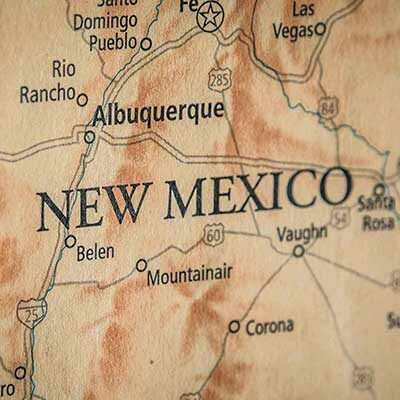PFAS found in bottled water, MD oyster waters, and the blood of a Wisconsin activist
Laura Paskus
October 13, 2020
Here in New Mexico, two Air Force bases have contaminated groundwater with PFAS, or per- and polyfluoroalkyl substances. Five other military sites in the state have been identified as possibly having contaminated local waters, as well.
PFAS contamination might not garner many headlines in New Mexico, but all across the country, communities are grappling with similar problems.
There are more than 7,000 chemicals in the PFAS family, and they share a few key traits – namely that they’re associated with an array of health problems and they’re considered “forever” chemicals because they don’t biodegrade.
In Wisconsin, a well-known activist has been diagnosed with cancer. According to the story:
[Sandy] Wynn-Stelt has lived more than 30 years across from the old House Street dump, where Wolverine Worldwide dumped PFAS-tainted sludge for years.
The source of the PFAS was the Scotchgard that the Rockford-based shoemaker used for waterproofing.
Tests found 5 million parts per trillion of PFAS in her blood — the highest ever recorded in a human.
The U.S. Environmental Protection Agency has yet to set regulatory limits on PFAS, but under the agency’s health advisory, you shouldn’t ingest more than 70 parts per trillion of two chemicals in the PFAS family—PFOA (perfluorooctanoic acid) and PFOS (perfluorooctanesulfonic acid)—over the course of your lifetime.
In the waters below Cannon Air Force Base in Clovis, PFAS levels were more than 370 times that lifetime limit. And at Holloman Air Force Base in Alamogordo, PFAS levels were more than 27,000 times the lifetime limit.
PFAS hasn’t shown up in the state’s tests of Maryland oysters, according to a story from The Southern Maryland Chronicle, but activists are still concerned about low levels in the waters near Naval Air Station Patuxent River. From the story by Timothy Wheeler:
Sampling done by the Maryland Department of the Environment detected no PFAS, or per– and polyfluoroalkyl substances, in oysters collected from rivers and creeks near Naval Air Station Patuxent River. Surface waters sampled where those oysters were growing registered what officials described as “very low” levels of the chemicals.
Some environmental activists, though, questioned the state’s interpretation of its findings — in part because they came up with somewhat different results from their own oyster testing. But they also note that what the MDE considers very low levels in water are well above PFAS exposure thresholds recommended in the European Union, and they question whether officials here are doing enough to identify and set safe standards for public health.
According to Consumer Reports, the toxins are also found in many popular brands of bottled water—carbonated and noncarbonated. To see those lists, visit their website. And Bloomberg Law reports that 60% of public water supply wells that were tested in California revealed the presence of PFAS.
The U.S. Environmental Protection Agency has yet to set regulatory limits on PFAS, but under the agency’s health advisory, you shouldn’t ingest more than 70 parts per trillion of two chemicals in the PFAS family—PFOA (perfluorooctanoic acid) and PFOS (perfluorooctanesulfonic acid)—over the course of your lifetime.
In the waters below Cannon Air Force Base in Clovis, PFAS levels were more than 370 times that lifetime limit. And at Holloman Air Force Base in Alamogordo, PFAS levels were more than 27,000 times the lifetime limit.
PFAS hasn’t shown up in the state’s tests of Maryland oysters, according to a story from The Southern Maryland Chronicle, but activists are still concerned about low levels in the waters near Naval Air Station Patuxent River. From the story by Timothy Wheeler:
Sampling done by the Maryland Department of the Environment detected no PFAS, or per– and polyfluoroalkyl substances, in oysters collected from rivers and creeks near Naval Air Station Patuxent River. Surface waters sampled where those oysters were growing registered what officials described as “very low” levels of the chemicals.
Some environmental activists, though, questioned the state’s interpretation of its findings — in part because they came up with somewhat different results from their own oyster testing. But they also note that what the MDE considers very low levels in water are well above PFAS exposure thresholds recommended in the European Union, and they question whether officials here are doing enough to identify and set safe standards for public health.
According to Consumer Reports, the toxins are also found in many popular brands of bottled water—carbonated and noncarbonated. To see those lists, visit their website. And Bloomberg Law reports that 60% of public water supply wells that were tested in California revealed the presence of PFAS.
In Wisconsin, the state’s Department of Natural Resources and PFAS Action Council is seeking public comment on its PFAS Action Plan. In that state, PFAS has been found in groundwater, surface water, drinking water, and the tissue of fish and animals.
New Mexico doesn’t have a PAFS Action Plan, but if you’re curious what Wisconsin’s draft looks like, you can view it here.
The Intercept takes an in-depth look into the EPA’s inaction regulating PFAS, and the U.S. Department of the Defense’s inaction on cleanup. Without enforceable regulatory limits, the military can continue to avoid responsibility for cleanup. According to Sharon Lerner’s story:
The EPA hasn’t officially backed away from its plan for the hazardous designation, but in January, the White House weighed in against the PFAS Action Act, saying that it “would create considerable litigation risk, set problematic and unreasonable rulemaking timelines and precedents, and impose substantial, unwarranted costs on Federal, State, and local agencies and other key stakeholders in both the public and private sectors.”
Some of the resistance in taking steps to regulate PFAS comes from the Department of Defense, according to Betsy Southerland, who worked at the EPA for 30 years and most recently served as director of science and technology in the Office of Water. Southerland resigned in protest of industry influence over the agency in 2017. The Defense Department reacted badly to the EPA’s release of a drinking water health advisory for PFOA and PFOS in 2016, according to Southerland, who oversaw the work on the health advisory. “DOD knew they had all this contamination, so they were furious,” she said.
Lastly, The Diplomat looks at how the U.S. military has polluted the drinking water of 450,000 Okinawans—plus thousands of U.S. service members and their families—with PFAS.
If you’ve been affected by PFAS contamination in your community here in New Mexico, call our tip line at (505) 433-7242. To read more coverage of PFAS in New Mexico visit “Groundwater War: New Mexico’s Toxic Threat,” which includes a timeline of events and studies on PFAS.






